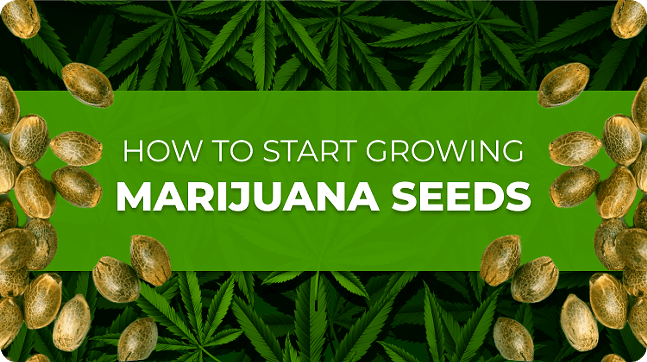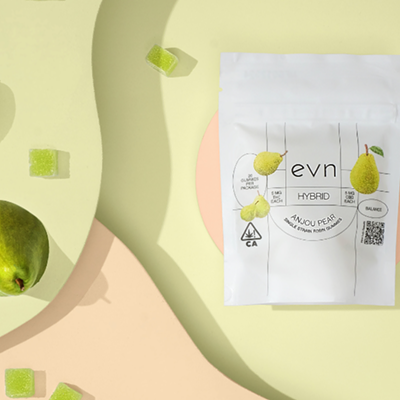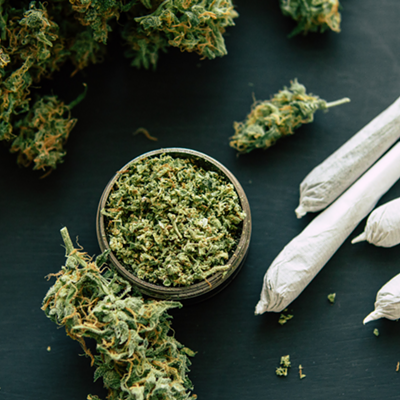Initiating the process of growing marijuana seeds requires a meticulous focus on proper germination methods. The germinated cannabis seeds play a critical role in establishing the foundation for successful cannabis cultivation. In this guide, I will explore essential best practices and tips to ensure the optimal start of your marijuana seed growth.
Throughout the article, we will cover key topics such as selecting the right seeds, understanding germination methods, creating ideal growth conditions, and addressing potential challenges in each stage. Every step in this process is interconnected, underlining the importance of a well-informed and systematic approach. Whether you are a beginner or an experienced cultivator, the goal is to provide you with the knowledge and insights necessary for a successful and productive cannabis cultivation experience right from the outset.
How to Start Growing Marijuana: Choosing Seeds
The first step on your cannabis plant cultivation journey is choosing the right seeds. Understanding the differences between strains is paramount. In this section, we'll discuss essential aspects of germination, including the marijuana life cycle, various types of seeds, and factors influencing seed selection and quality. By this segment's end, you'll understand the nuances between regular, feminized, autoflowering, and photoperiod seeds. I'll also provide personal expert tips and highlight examples, equipping you with the knowledge needed to make informed choices. Whether you're a novice or a seasoned grower, these insights will guide you in selecting seeds tailored to your preferences and growing environment.
Marijuana Life Cycle
The marijuana life cycle unfolds in distinct stages, commencing with germination, where the cannabis seed transforms into a delicate seedling, prioritizing the development of a sturdy root system. Progressing into the vegetative stage, the plant experiences significant leaf and stem growth, channeling energy toward structural reinforcement.
The transition to the flowering stage is pivotal, revealing the plant's gender, crucial for distinguishing between male and female specimens. Female plants take center stage, producing resinous buds vital for consumption. The flowering phase significantly impacts the potency and yield of the final cannabis product. Maturity marks the conclusion of the marijuana life cycle, with successful navigation through each stage, including considerations of light exposure, nutrient provision, and environmental management, which are crucial for cultivating robust, healthy plants..
Types of Marijuana Seeds
Regular marijuana seeds are the most natural and unaltered form, carrying a 50/50 chance of developing into a male or female plant. Feminized cannabis seeds, on the other hand, are genetically modified to ensure a higher probability of yielding female plants, the gender most sought after for bud production. Autoflowering seeds have gained popularity due to their ability to flower automatically, independent of light cycles, making them suitable for novice growers and those with limited space. Photoperiod seeds rely on changes in light cycles to trigger flowering, providing more control over the growth stages.
Personal Expert Tip: Consider your cultivation goals and experience level when choosing the seed type, as each has unique advantages. Examples of well-regarded strains include Northern Lights for regular seeds, Girl Scout Cookies for feminized seeds, Blue Mystic for autoflowering seeds, and White Widow for photoperiod seeds.
Seed Selection and Quality
Selecting high-quality cannabis seeds is a critical step in ensuring a successful cultivation journey. Appearance, firmness, and color are indicative of seed health. Choose seeds with a dark color, indicating maturity and viability. A firm outer shell suggests good genetics and resilience. Subtle patterns and a waxy coating are signs of a healthy, well-preserved seed. When squeezed, high-quality seeds should resist cracking under pressure.
Personal Expert Tip: Obtain seeds from reputable breeders, as quality assurance significantly impacts the success of your crop. Consider the strain's characteristics and your cultivation environment when making your selection. Remember, healthy seeds lay the foundation for robust and high-yielding plants.
Cannabis Strains & Easiest Seeds Home Germination
Certain cannabis strains are more forgiving and easier for home germination, making them ideal for novice growers. Strains like Blue Dream, Green Crack, and Northern Lights are renowned for their resilience and adaptability.
Personal Expert Tip: Start with strains with straightforward cultivation requirements, such as resistance to pests and diseases, manageable height, and a forgiving nature regarding environmental fluctuations. Blue Dream, for instance, is known for its robust growth, making it a suitable choice for beginners. Green Crack's hardy nature and resistance to common issues make it another excellent option. In contrast, with its compact size and pest resistance, Northern Lights is a favorite among those new to cannabis cultivation.
Indica vs Sativa
Indica and Sativa are the two primary subspecies of cannabis, each offering distinct effects and growth characteristics. Indica strains are known for their relaxing sedative effects, making them suitable for evening use. They typically have shorter flowering times and compact, bushy structures.
Sativa strains, conversely, provide energizing and uplifting effects, suitable for daytime consumption. Sativas often have more extended flowering periods and taller, more stretchy growth patterns. Personal expert tip: Tailor your strain selection to your desired effects and the available cultivation space. Examples include OG Kush, a popular Indica strain known for its relaxing properties, and Sour Diesel, a Sativa-dominant strain celebrated for its energizing effects.
Where to Buy Cannabis Seeds: Online Seed Banks
Exploring online seed banks has become my go-to method for acquiring top-notch cannabis seeds tailored to my preferences. These platforms offer a secure and practical solution, ensuring a diverse genetic selection and discreet and reliable delivery. In this guide, I'll share insights into the benefits of buying cannabis seeds online and highlight the distinctive features of these trusted vendors.
DNA Genetics: Best Marijuana Seed Bank for Connoisseurs and Experienced Growers
ILGM: Best Marijuana Seed Bank for Beginners and Educational Resources
DNA Genetics: Best for Connoisseurs and Experienced Growers
Celebrating its 20th anniversary, DNA Genetics is a true OG and the most awarded company in the industry. The founders, renowned as world-class breeders, have significantly influenced the global cannabis landscape. Spending two decades perfecting strains in Amsterdam, they now make these genetics directly accessible to consumers, strengthening the Cali-Amsterdam connection.
As pioneers, DNA Genetics was one of the first major companies to distribute seeds worldwide, with proven genetics that consistently win awards. The founders' journey included relocating to Amsterdam to craft the best genetics and shape the global cannabis community.
DNA Genetics, with over 20 years of expertise, focuses on the United States and Canada, offering a range of premium strains like Kosher Kush and Tangie. The user-friendly website features diverse seed categories, loyalty programs, and enticing promotions, making it a top choice for cannabis enthusiasts in North America. A detailed Returns and Refunds Policy underscores the company's commitment to customer satisfaction, ensuring a seamless and secure shopping experience. In summary, DNA Genetics emerges as a powerhouse with a rich history, delivering top-notch genetics and unparalleled service to customers.
ILGM: Best for Beginners and Educational Resources
ILGM (I Love Growing Marijuana) has become a trusted source of regular marijuana seeds. Leveraging Bergman's 25 years of cultivation expertise, ILGM stands out for its commitment to quality, offering a diverse selection of strains, including popular choices like Sour Diesel and White Widow, starting at $69 for five seeds.
What sets ILGM apart is its customer-centric approach, exemplified by free shipping to every U.S. state and its website's comprehensive array of educational resources. Catering to novice and experienced growers, ILGM provides premium seeds and extensive support, ensuring an optimal cultivation experience.
While specific prices for strains are not detailed, ILGM maintains a competitive pricing structure. Positive customer reviews consistently highlight the value for money, praising successful growth, prompt shipping, and the transparent policies that contribute to ILGM's reputation as a reliable seed bank. With a steadfast focus on quality, education, and dedicated customer support, ILGM remains a destination for growers seeking premium seeds at competitive prices.
Preparing for Germination of Marijuana Seeds
Commencing the germination process for marijuana seeds demands thorough preparation to ensure successful cultivation. Before getting into germination's complexities, a robust foundation is laid through meticulous preparation. During this phase, examining three prevalent germination methods—specifically, the paper towel, water glass, and direct planting—becomes a focal point.
Understand Germination Methods
Preparing for the germination of marijuana seeds is crucial in ensuring a successful cultivation journey. Before delving into the intricacies of germination, thorough preparation becomes the foundation for cultivating healthy and robust cannabis plants. In this phase, exploring three popular germination methods—paper towel, water glass, and direct planting—takes center stage.
The paper towel method involves placing seeds between moist paper towels, creating a controlled environment that encourages germination. This method allows cultivators to monitor the initial stages of seed development closely. The water glass method entails soaking seeds in a glass of water until they sprout roots, providing a straightforward approach for beginners. Direct planting involves placing seeds directly into the growing medium, offering simplicity and minimizing potential stress on the emerging seedlings.
Gather the Equipment
In the crucial phase of gathering equipment for germinating marijuana seeds, beginner growers must be equipped with specific tools to ensure a successful cultivation journey. Essential tools include high-quality germinate seeds, a suitable growing medium like peat pellets or seedling trays, grow lights to provide adequate lighting, proper ventilation systems to maintain optimal airflow, and a humidity dome to control moisture levels.
High-quality seeds are the foundation, ensuring the genetic potential of the plants. A suitable growing medium, such as peat pellets or seedling trays, provides a supportive environment for seed germination. LED or fluorescent lights and grow lights provide the necessary light intensity during the early growth stages. Proper ventilation systems help maintain optimal airflow, preventing issues like mold or mildew. The humidity dome regulates moisture levels, creating a microclimate ideal for seedling development. By understanding the role of each tool, novice growers can create an environment conducive to successful germination, laying the groundwork for a thriving cultivation journey.
Check Optimal Conditions
Transitioning to the critical phase of checking optimal conditions, it is imperative to delve into specific details for a successful germination process. Temperature regulation is crucial, with an optimal range typically between 75°F to 80°F (24°C to 27°C) during germination. This warmth supports the activation of enzymes and metabolic processes vital for seedling emergence. Light exposure plays a pivotal role, and maintaining a light intensity of approximately 300 to 500 micromoles per square meter ensures that emerging seedlings receive adequate light for robust growth. Investing in full-spectrum LED or fluorescent lights tailored for seedlings can optimize this aspect of the germination environment.
Humidity levels are equally important, with an ideal 70% to 80% range. This prevents desiccation of seeds and seedlings, creating a moisture-rich atmosphere for optimal germination, and using a humidity dome or covering trays with a plastic wrap aids in maintaining these optimal humidity levels. Soil moisture management completes the quartet of crucial conditions. The soil should be consistently moist but not soggy. Employing a well-draining germination mix and watering with care ensures that seeds have the correct moisture balance to initiate successful germination. By attending to these nuanced details in temperature, light exposure, humidity, and soil moisture, cultivators lay the groundwork for an environment that maximizes the chances of a thriving germinating cannabis seeds cultivation journey.
Growing Marijuana Seeds: Best Practices & Tips
Preventing Pests and Diseases
Cannabis plants, like any other crops, are vulnerable to a range of pests and diseases. Implementing preventive measures is fundamental to fostering a healthy crop. Conducting regular inspections of your plants allows early detection of potential issues. Proper sanitation practices, such as keeping the growing area clean and debris-free, help create an environment less conducive to pests and diseases.
In addition to proactive measures, organic pesticides can ward off common pests. Organic pest control methods include neem oil, insecticidal soaps, and beneficial predatory insects. Recognizing early signs of pests or diseases, such as unusual spots on leaves or changes in plant color, enables prompt intervention. Timely and effective action ensures a robust and thriving cannabis crop, emphasizing the significance of a proactive approach to pest and disease management.
Providing Proper Nutrients
Ensuring optimal nutrient levels is key to promoting healthy growth in marijuana plants. Understanding common nutrient deficiencies and excesses during the early growth stages is crucial for cultivators. Essential nutrients, including nitrogen (N), phosphorus (P), and potassium (K), play pivotal roles in various aspects of plant development.
Nitrogen supports lush and vegetative growth, phosphorus aids in root development and flowering, and potassium contributes to overall plant health. Organic and synthetic nutrient options offer flexibility, and cultivators must know the advantages and considerations associated with each. Organic nutrients derived from natural sources provide a more sustainable and environmentally friendly option. On the other hand, synthetic nutrients offer precise control over nutrient levels but require careful monitoring to prevent over-fertilization.
Knowing Local Laws and Regulations
Local laws regarding the cultivation, possession, and distribution of cannabis can vary widely. Understanding the legal framework in your region, including licensing requirements and restrictions, is crucial for a seamless cultivation experience. Compliance with local laws avoids legal complications and contributes to the cultivation venture's overall success.
Awareness of legal obligations empowers cultivators to make informed decisions and build a cultivation strategy that aligns with regulatory requirements. Staying updated on changes in local laws ensures ongoing compliance and a responsible approach to cannabis cultivation.
Managing Light and Watering
For indoor cultivation, ensuring that seedlings receive sufficient light is crucial. Light exposure should be well-regulated, preventing stretching or weak seedlings. Using artificial lights with the right spectrum and intensity helps create an environment conducive to optimal growth.
A balance between hydration and avoiding waterlogged conditions is essential in terms of watering. Overwatering can lead to root rot and other complications, while underwatering can stunt growth. Personal expert tips include monitoring soil moisture levels, using well-draining soil, and adjusting watering frequency based on plant needs.
Topping & Harvesting at the Right Time
Recognizing the opportune moment for topping and harvesting is critical in cannabis cultivation. Topping involves removing the growing tip to promote lateral growth and bushier plants. Timing is crucial, and expert tips underscore the importance of careful observation and adherence to the right timing. Waiting until the plant has sufficient growth, typically a certain height or number of nodes, ensures a successful topping process, with personalized advice emphasizing understanding the specific requirements of the chosen cannabis strain.
Similarly, harvesting at the right time maximizes cannabinoid content and overall quality. Expert tips emphasize factors such as trichome color and maturity as indicators of readiness for harvest. Harvesting too early or too late can affect potency and the overall quality of the final product, underscoring the need for precision in the harvesting process. In conclusion, mastering these best practices enhances the likelihood of a successful cannabis cultivation journey. Each aspect, from pest prevention to nutrient management, legal compliance, and precise cultivation techniques, is crucial in achieving optimal results. As cultivators navigate through the growing cannabis stage, a combination of knowledge, observation, and dedication sets the stage for a thriving and rewarding cannabis crop.
How to Start Growing Marijuana Seeds: FAQs
What Is the Best Month to Plant Marijuana Seeds?
The ideal month for planting marijuana seeds depends on local climate conditions. Considering regional weather patterns and optimal growing conditions aids in planning a successful cultivation season.
How Hard Is It to Grow Marijuana?
Cultivating marijuana can be moderately challenging, requiring research and dedication. Beginning with beginner-friendly strains and gradually expanding cultivation skills is advisable for novice growers.
Can I Start Marijuana Seeds Directly in Soil?
Commencing marijuana seed growth directly in the soil is viable, provided the soil is well-draining and nutrient-rich. Personal expert tips emphasize the importance of soil quality for successful seedling development.
What Is the Hardest Part of Growing Marijuana?
The most challenging aspects of growing marijuana encompass maintaining optimal environmental conditions, preventing pests and diseases, and ensuring a balanced nutrient profile throughout the plant's life cycle.
What Is the Best Temperature to Start Marijuana Seeds?
Maintaining a temperature range between 70°F and 85°F is optimal for initiating marijuana seed growth. Personal expert tips underscore the use of temperature control measures for creating a conducive germination environment.
How Long Does It Take for a Marijuana Plant to Start Producing Bud?
The timeline for a marijuana plant to begin producing buds varies. Patience is crucial, with close monitoring of plant development and adjustment of cultivation practices contributing to a successful outcome.
Related
Conclusion on Starting to Grow Marijuana Seeds
As we conclude this guide on starting to grow marijuana seeds, I encourage you to embark on this rewarding journey of cultivation. You're setting the stage for a successful and fulfilling experience by implementing the best practices and tips discussed. From selecting the right seeds to mastering germination methods, managing optimal conditions, and navigating through the growth stages, each step is a crucial part of your cannabis cultivation venture.
For a diverse and high-quality genetic selection, remember to explore reputable online seed banks like Seedsman, Crop King Seeds, and ILoveGrowingMarijuana (ILGM). You ensure a responsible and prosperous cultivation journey by adhering to local laws and regulations, preventing pests and diseases, providing proper nutrients, and mastering height control.
In cannabis cultivation, attention to detail and dedication are key. Whether you're a novice or a seasoned grower, the satisfaction of nurturing your cannabis plants and enjoying the final harvest is unparalleled. So, take the plunge, apply the knowledge gained from this guide, and watch your cannabis seeds transform into a thriving and bountiful crop.
Disclaimer: This article does not encourage readers to grow marijuana where it is not legal to do so. It is highly recommended to check legal questions before purchasing these products.




















